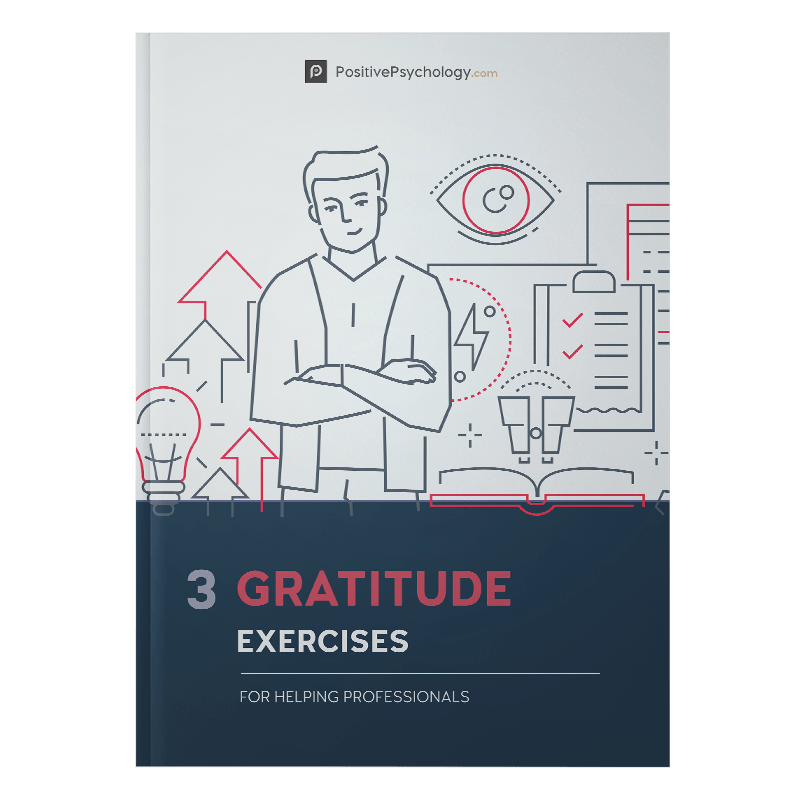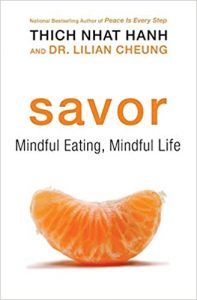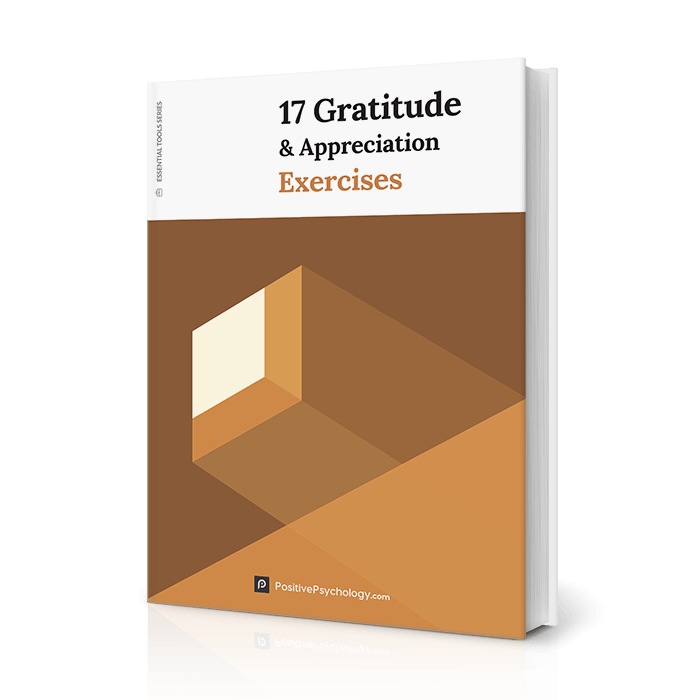Savoring in Positive Psychology: 21 Tools to Appreciate Life
 It’s challenging to focus on the bright side while living in a fast-paced world and being immersed in an influx of information heavily centered on negative events.
It’s challenging to focus on the bright side while living in a fast-paced world and being immersed in an influx of information heavily centered on negative events.
While adversity is part of our common humanity, it does not mean that there is no space for brighter things to happen. Intentionally placing our attention on positive events and prolonging the positive feelings that arise can buffer against negative health outcomes and enable wellbeing.
Before you continue, we thought you might like to download our three Gratitude Exercises for free. These detailed, science-based exercises will help you or your clients connect to more positive emotions and enjoy the benefits of gratitude.
This Article Contains:
- What Does Savoring Mean in Psychology?
- 12 Benefits of Savoring Life
- 10 Inspiring Savoring Exercises for Your Clients
- 11 Positive Psychology Savoring Interventions
- A Note on Savoring the Past
- 3 Books on the Topic
- Quotes About Savoring Life
- PositivePsychology.com’s Relevant Tools
- A Take-Home Message
- References
What Does Savoring Mean in Psychology?
Bryant and Veroff (2007) define savoring as attending, appreciating, and enhancing positive experiences that occur in one’s life.
In searching for a term that could accurately depict the process of attending to the experience of enjoyment, Bryant and Veroff (2007) decided to use the word savoring. The term denotes a process and represents the counterpart of coping.
It entails an active behavior and acknowledges the interaction between the person and their environment, with a focus on the experience of delight in its broadest sense (Bryant & Veroff, 2007).
This means that savoring can be associated with an internal or external event, which might not necessarily be tangible (Smith & Bryant, 2017).
Although intimately related to pleasure, savoring is more about becoming aware of the experience of pleasure and appreciating the positive emotions derived from that experience. To savor an experience, one must possess and apply a certain degree of mindfulness and meta-awareness (Bryant & Veroff, 2007).
3 Types of savoring
- Savoring the past, also known as reminiscence. For example, remembering funny moments from school with a friend.
- Savoring the present or savoring the moment. For instance, enjoying a new meal by drawing your attention to the flavors and smells.
- Savoring the future, also referred to as anticipation. For example, visualizing the trip you have planned with your partner for this upcoming weekend.
3 Levels of savoring
1. Savoring experiences
It refers to the overall experience while intentionally focusing your attention on appreciating positive events. It includes sensations, emotions, perceptions, thoughts, and behaviors that are linked to the particular environment in which you are immersed (Bryant & Veroff, 2007). An example of this level is sitting at the beach feeling the ocean breeze while watching the sunset.
2. Savoring processes
These processes connect a positive event to positive emotions by modulating different positive states. For example, the process of appreciating a kind action from a stranger regarded as beneficial regulates gratitude as a positive emotional state (Bryant & Veroff, 2007).
3. Savoring responses
These are the specific behaviors or thoughts emerging as a response to a positive event. These responses regulate the influence of such positive events on positive affect by either amplifying or dampening the intensity and duration of positive emotions (Bryant & Veroff, 2007).
Preconditions to savoring
According to Smith and Bryant (2017), the following elements should be present in order to develop and experience your savoring ability:
- Being able to connect to the present moment
- Freedom from urgent social responsibilities
- Basic physical and psychological needs are covered
- Presence of mindfulness and meta-awareness regarding positive experiences
Differences between savoring and other concepts
According to Bryant and Veroff (2007), savoring may overlap with other terms but has distinctive features.
Here are some of them:
- Mindfulness
Although savoring involves mindfulness, it is a much narrower process. Savoring involves intentionally attending to the present experience, specifically focusing on internal or external stimuli exclusively related to positive feelings. - Meditation
Savoring also differs from meditation in that savoring does not aim to transcend the self, but to focus on pleasant feelings experienced by the self. - Daydreaming
Savoring differs from daydreaming since the latter implies detachment from the immediate environment; savoring implies drawing experiences from that environment. - Flow
Although flow involves enjoyment of the activity in which people engage in, it entails much less conscious attention to the experience than savoring. Additionally, savoring does not necessarily involve challenge.
12 Benefits of Savoring Life

Since savoring processes entail the amplification or persistence of positive emotions, it can be positively associated with higher levels of subjective wellbeing (Smith & Bryant, 2017). It is important to note that the benefits of savoring derive from the process and personal experience rather than from the positive nature of the event.
Some documented benefits of developing and using an increased savoring ability include the following:
- Counterbalances the experience of unpleasant emotions during stressful events (Zautra, Affleck, Tennen, Reich, & Davis, 2005)
- Boosts happiness in people experiencing fewer daily positive events (Jose, Lim, & Bryant, 2012)
- Predicts greater levels of positive affect and self-esteem in primary school children (Bryant & Veroff, 2007)
- Predicts higher levels of life satisfaction, happiness, and perceived control in adolescents and older adults (Bryant, 2003)
- Predicts decreased depressive symptoms in older adults (Smith & Hollinger-Smith, 2015)
- Predicts reduced levels of depression and anxiety in Chinese caregivers (Hou et al., 2016)
- Predicts decreased levels of obsessive-compulsive disorder and social phobia in U.S. undergraduates (Eisner, Johnson, & Carver, 2009)
- Positively relates to higher levels of positive affect and life satisfaction (Quoidbach, Berry, Hansenne, & Micolajczk, 2010)
- Positively influences satisfaction in long-distance romantic relationships through increased positive affect (Borelli, Rasmussen, Burkhart, & Sbarra, 2015)
- Relational savoring, such as explicit disclosure of positive events to a partner, increases the quality of the relationship and levels of self-esteem (Pagania et al., 2015)
- Helps people balance family and career responsibilities more effectively (Camgoz, 2014)
- Promotes positive relationships when experiencing a wholehearted response to a narrated positive event by other people (Reis, Smith, Tsai, Rodriguez, & Maniaci, 2010)
10 Inspiring Savoring Exercises for Your Clients
Bryant and Veroff (2007) distinguish 10 savoring strategies for modulating positive emotions during positive events.
- Sharing with others
Actively seeking and including other people in personal positive experiences and listening to shared stories about past events or future plans can amplify positive emotions. They might point out relevant positive details we may have missed from an event. Also, watching their emotional response can increase one’s own positive emotions. - Memory building
By intentionally creating a memory, people can choose the elements from that experience that evoke more pleasure in order to savor that moment to the fullest. Taking a mental picture of an event or keeping a journal or scrapbook to document special moments are some examples of how to build memories. - Self-congratulation
Savoring individual or collective success by relishing achievements is another way to amplify positive feelings. - Sensory-perceptual sharpening
Purposefully focusing attention on specific features of an experience can enable people to deepen their positive experience or explore it in more detail. Sitting in front of the ocean with your eyes closed while listening to the sound of the waves is a way to narrow your attention and enhance the inner delight generated from the sound. - Comparing
Taking time to reflect on how a particular experience is better is another savoring strategy. You can compare the experience to a different setting (counterfactual comparison), the past (temporal comparison), or what other people experience (social comparison) to increase and prolong positive emotions. - Absorption
Although similar to flow, absorption requires periods of awareness of positive emotions while being immersed and engaged in a particular experience. This can promote the sensation of slowing down and the feeling of positive moments being prolonged. - Behavioral expression
By physically manifesting positive emotions, people can amplify those feelings. Some examples of expressing emotion may include laughing, shouting, and clapping while celebrating a special occasion. - Temporal awareness
Bringing awareness to the fleeting nature of a positive experience can motivate people to savor the moment and make the most out of it before it ends. - Counting blessings
By attending to and reflecting on a positive experience and the reasons one might be grateful for that experience, people can foster positive feelings. - Avoiding kill-joy thinking
Evading downplay and devaluation of positive experiences by not focusing on imperfections can promote lasting positive feelings. However, this might apply only to some cultures, since some contexts value dampening strategies to regulate positive emotions.
11 Positive Psychology Savoring Interventions

Past-focused savoring interventions
- Thinking about positive events (Lyubomirsky, Sousa, & Dickerhoof, 2006)
Spending 15 minutes throughout three days savoring a positive experience by actively reflecting on thoughts and emotions related to it was found effective in enhancing wellbeing and happiness. - Positive reminiscence (Bryant, Smart, & King, 2005)
Spending two sessions of 10 minutes each day over one week using memorabilia or positive imagery to reminiscence about positive events demonstrated increased positive affect. - Three good things (Seligman, Steen, Park, & Peterson, 2005)
Noticing and writing down three events and reflecting on the reasons why they happened can boost happiness levels for up to six months. - Basking in achievement and acknowledging the role of others (Keeney, 2009)
Spending 10 minutes each day over two days writing about either a personal achievement and how obstacles were overcome or recognizing the role of others in a personal achievement can increase positive affect. - Reflecting on acts of kindness (Otake, Shimai, Tanaka-Matsumi, Otsui, & Fredrickson, 2006)
Recording acts of kindness toward others daily over seven days can boost positive emotions.
Present-focused savoring interventions
- Increasing the use of savoring strategies (Hurley & Kwon, 2012)
Reflecting on recent positive events and how one could apply savoring strategies in such events can be helpful to purposefully apply those strategies in other situations and to reduce negative affect. - Adopting a positive focus (Bryant & Veroff, 2007)
Taking a daily 20-minute walk while trying to notice as many positive elements as possible can increase happiness levels after one week. - Mindful photography (Kurtz, 2012)
Taking meaningful and awe-inspiring photographs for at least 15 minutes twice a week can enhance mood in the short term. - Daily savoring exercises (Schueller, 2010)
Using different present moment savoring exercises daily, one week for each exercise, and taking a few minutes to engage in the experience can boost happiness after one week of finalizing the intervention.
Future-oriented savoring interventions
- Positive imagination (Quoidbach, Wood, & Hansenne, 2009)
Visualizing four positive events that are likely to happen tomorrow each day for two weeks can increase positive affect. - Benefiting from scarcity (O’Brien & Ellsworth, 2012)
Thinking about the impermanence of a positive event can enhance the savoring experience and bring about higher levels of positive emotions.
Smith et al. (2014) conducted a meta-analysis including the above-mentioned interventions and found that there were no significant differences between past, present, and future-oriented savoring interventions. The strength of their effectiveness was related to the length of the intervention over time and the frequency of the intervention.
Although in general, a daily intervention lasting two weeks or more might be more effective, personal characteristics should always be taken into account. Most of the studies assessing these interventions have a limited sample diversity and might not apply to everyone. However, people experiencing lower positive affect might benefit more from them as there is more room for improvement.
A Note on Savoring the Past

The capacity to savor past experiences can improve emotional regulation and consequently enhance people’s response to stressful events and resilience.
However, depressed individuals tend to struggle with noticing positive events, remembering positive autobiographical memories, and using this strategy to evoke and prolong positive emotions (Speer et al., 2014).
Comparing past events to the present moment can be a beneficial savoring strategy, but it works only when the present is better than the past. When the present experience is perceived as worse than similar past experiences, the ability to savor can be thwarted.
This can happen when reflecting on how a current experience was better in the past, worse than other people’s experiences, or worse than what could have happened (Smith & Bryant, 2017).
Although experiencing negative circumstances can overwhelm and affect our ability to notice, appreciate, and savor positive events, overcoming those challenges can also improve savoring by offering a comparison point for current positive experiences (Croft, Dunn, & Quoidbach, 2014). The selection of the savoring strategies and interventions should always consider personal and contextual factors of your client.
3 Books on the Topic
1. Savoring: A New Model of Positive Experience – Fred B. Bryant and Joseph Veroff
This book delves into the psychology of enjoyment by exploring theoretical and empirical foundations of savoring.
It explores the conditions under which savoring most likely occurs and reviews measurements to evaluate and study this construct.
Positively reviewed by both Mihaly Csikszentmihalyi and Martin Seligman, the book is well researched.
Additional chapters provide insight into enhancing savoring, which can be very useful for interventions.
Find the book on Amazon.
2. Encyclopedia of An Ordinary Life: A Memoir – Amy Krouse Rosenthal

This book examines ordinary life moments to appreciate the extraordinary quality underneath them.
Described as ‘amusing, poetic, lovely, different and offbeat,’ this book is an odd mixture that comes highly recommended.
Find the book on Amazon.
3. Savor: Mindful Eating, Mindful Life – Thich Nhat Hanh and Lilian Cheung
Co-written by a Buddhist monk and a Western doctor, this book explores how savoring and mindful eating can help people enjoy eating and develop a healthy relationship with food.
As reviewed by Tricycle Magazine:
“Not your average healthy-eating guide. ‘Savor’ may have us rethinking every bite, but maybe that’s just what we need.”
Find the book on Amazon.
Quotes About Savoring Life
Happiness is a thing to be practiced, like the violin.
Sir John Lubbock
Man is fond of counting his troubles, but he does not count his joys.
Fyodor Dostoevsky
Men are disturbed not by things, but by the views which they take of things.
Epictetus
Even in the mud and scum of things, something always, always sings.
Ralph Waldo Emmerson
The most visible joy can only reveal itself to us when we’ve transformed it, within.
Rainer Maria Rilke
You don’t experience life by drinking coffee fast. You experience life by savoring every last drop.
Anthony T. Hincks
You also might enjoy listening to these songs from two famous musicals that allude to savoring:
“My Favorite Things” from The Sound of Music
“Wouldn’t It Be Loverly?” from My Fair Lady
PositivePsychology.com’s Relevant Tools
You can try these worksheets to develop mindfulness skills to enhance your savoring abilities:
These worksheets might help you experience savoring in different ways:
- Practice intentionally planning positive events with the Pleasant Activities Scheduling Worksheet if you find it hard to search for positive experiences.
- Practice reminiscence by using this Gratitude Journal.
- Connect and savor your natural environment by using this Nature Play worksheet.
- Experience a raisin to savor the present moment while exploring it with all your senses.
If you’re looking for more science-based ways to help others harness the benefits of gratitude, this collection contains 17 validated gratitude tools for practitioners. Use them to help others shift to a more positive mindset and experience the joys of life more deeply.
A Take-Home Message
Savoring can be a simple and evocative way to boost your happiness.
It is easily accessible through everyday activities such as finding delight in petting your cat, sipping your morning coffee, evoking gratitude for daily events before going to bed, or feeling the joy of anticipating an encounter with your loved one.
Most of the benefits of savoring have been measured and reported regarding subjective wellbeing and happiness levels. Although this offers a narrow perspective, there is an extensive body of research on the long-lasting positive effects of positive emotions, which can be highly relevant for other dimensions of wellbeing.
And finally, considering how well an intervention can fit a particular individual at a particular time and context can be crucial to reap the benefits to the fullest. There is a wide array of savoring strategies and interventions that have been scientifically studied and documented.
You can start by trying out some of them to find your best fit and incorporate them into your daily routine to build positive emotions and wellbeing.
We hope you enjoyed reading this article. Don’t forget to download our three Gratitude Exercises for free.
- Borelli, J. L., Rasmussen, H. F., Burkhart, M. L., & Sbarra, D. A. (2015). Relational savoring in long-distance romantic relationships. Journal of Social and Personal Relationships, 32, 1083–1108.
- Bryant, F. B. (2003). Savoring Beliefs Inventory (SBI): A scale for measuring beliefs about savouring. Journal of Mental Health, 12, 175–196.
- Bryant, F. B., Smart, C. M., & King, S. P. (2005). Using the past to enhance the present: Boosting happiness through positive reminiscence. Journal of Happiness Studies, 6, 227– 260.
- Bryant, F. B., & Veroff, J. (2007). Savoring: A new model of positive experience. Erlbaum Associates.
- Camgoz, S. M. (2014). The role of savoring in work–family conflict. Social Behavior and Personality, 42, 177–188.
- Croft, A., Dunn, E. W., & Quoidbach, J. (2014). From tribulations to appreciation: Experiencing adversity in the past predicts greater savoring in the present. Social Psychological and Personality Science, 5, 511–516.
- Eisner, L. R., Johnson, S. L., & Carver, C. S. (2009). Positive affect regulation in anxiety disorders. Journal of Anxiety Disorders, 23(5), 645–649.
- Hanh, T. N., & Cheung, L. (2011). Savor: Mindful eating, mindful life. HarperOne.
- Hou, W. K., Lau, K. M., Ng, S. M., Lee, T. M. C., Cheung, H. Y. S., Shum, T. C. Y., & Cheng, A. C. K. (2016). Psychological detachment and savoring in adaptation to cancer caregiving. Psycho‐Oncology, 25(7), 839–847.
- Hurley, D. B., & Kwon, P. (2012). Results of a study to increase savoring the moment: Differential impact on positive and negative outcomes. Journal of Happiness Studies, 13, 579–588
- Jose, P. E., Lim, B. T., & Bryant, F. B. (2012). Does savoring increase happiness? A daily diary study. The Journal of Positive Psychology, 7(3), 176–187.
- Keeney, J. (2009). Savoring success: Effects of basking and acknowledgment of others in response to achievement (Unpublished master’s thesis). Michigan State University, East Lansing, MI.
- Kurtz, J. L. (2012). Seeing through new eyes: An experimental investigation of the benefits of photography. Unpublished manuscript.
- Lyubomirsky, S., Sousa, L., & Dickerhoof, R. (2006). The costs and benefits of writing, talking, and thinking about triumphs and defeats. Journal of Personality and Social Psychology, 90, 692–708.
- O’Brien, E., & Ellsworth, P. C. (2012). Saving the last for best: A positivity bias for end experiences. Psychological Science, 23, 163–165.
- Otake, K., Shimai, S., Tanaka-Matsumi, J., Otsui, K., & Fredrickson, B. L. (2006). Happy people become happier through kindness: A counting kindness intervention. Journal of Happiness Studies, 7, 361–375.
- Pagania, A. F., Donatob, S., Parisea, M., Iafrateb, R., Bertonib, A., & Schoebic, D. (2015). When good things happen: Explicit capitalization attempts of positive events promote intimate partners’ daily well-being. Family Science, 6, 19–128.
- Quoidbach, J., Wood, A., & Hansenne, M. (2009). Back to the future: The effect of daily practice of mental time travel into the future on happiness and anxiety. Journal of Positive Psychology, 4, 349–355.
- Quoidbach, J., Berry, E. V., Hansenne, M., & Micolajczk, M. (2010). Positive emotion regulation and well-being: Comparing the impact of eight savoring and dampening strategies. Personality and Individual Differences, 49(5), 368–373.
- Reis, H. T., Smith, S. M., Tsai, F. F., Rodriguez, A., & Maniaci, M. R. (2010). Are you happy for me? How sharing positive events with others provides personal and interpersonal benefits. Journal of Personality and Social Psychology, 99, 311–329.
- Rosenthal, A. K. (2005). Encyclopedia of an ordinary life: A memoir. Crown.
- Schueller, S. M. (2010). Preferences for positive psychology exercises. Journal of Positive Psychology, 5, 192–203.
- Seligman, M. E. P., Steen, T. A., Park, N., & Peterson, C. (2005). Positive psychology progress. American Psychologist, 60, 410–421.
- Smith, J. L. & Bryant, F. B. (2017). Savoring and wellbeing: Mapping the cognitive-emotional terrain of the happy mind. In M. Robinson & M. Eid (Eds.), The happy mind: Cognitive contributions to wellbeing. Springer.
- Smith, J. L., Harrison, P. R., Kurtz, J. L., & Bryant, F. B. (2014). Nurturing the capacity to savor: Interventions to enhance the enjoyment of positive experiences. In A. C. Parks & S. M. Schueller (Eds.), The Wiley Blackwell handbook of positive psychological interventions (p. 42). John Wiley & Sons.
- Smith, J. L., & Hollinger-Smith, L. (2015). Savoring, resilience, and psychological well-being in older adults. Aging & Mental Health, 19(3), 192–200.
- Speer, M. E., Bhanji, J. P., & Delgado, M. R. (2014). Neural signals of positive autobiographical memory. Neuron, 84, 847–856.
- Tugade, M. M., & Fredrickson, B. L. (2007). Regulation of positive emotions: Emotion regulation strategies that promote resilience. Journal of Happiness Studies, 8, 311–333.
- Zautra, A. J., Affleck, G. G., Tennen, H., Reich, J. W., & Davis, M. C. (2005). Dynamic approaches to emotions and stress in everyday life: Bolger and Zuckerman reloaded with positive as well as negative affects. Journal of Personality, 73(6), 1511–1538.
Let us know your thoughts
Read other articles by their category
- Body & Brain (49)
- Coaching & Application (57)
- Compassion (26)
- Counseling (51)
- Emotional Intelligence (24)
- Gratitude (18)
- Grief & Bereavement (21)
- Happiness & SWB (40)
- Meaning & Values (26)
- Meditation (20)
- Mindfulness (45)
- Motivation & Goals (45)
- Optimism & Mindset (34)
- Positive CBT (28)
- Positive Communication (20)
- Positive Education (47)
- Positive Emotions (32)
- Positive Leadership (18)
- Positive Parenting (4)
- Positive Psychology (33)
- Positive Workplace (37)
- Productivity (16)
- Relationships (46)
- Resilience & Coping (36)
- Self Awareness (21)
- Self Esteem (38)
- Strengths & Virtues (31)
- Stress & Burnout Prevention (34)
- Theory & Books (46)
- Therapy Exercises (37)
- Types of Therapy (64)








What our readers think
Thankyou
What a lovely, practical well-researched article. It will be well used, thanks.
Altogether different and amazing perspective.
A great read
This is an amazing comprehensive article on the topic of Savoring! Thanks so much for sharing this!
Thank you so much!
This is an excellent article and relevant for scholars as well as practitioners. Thank you!
this is wonderful thank you so much x
Thank you for such an amazing article!